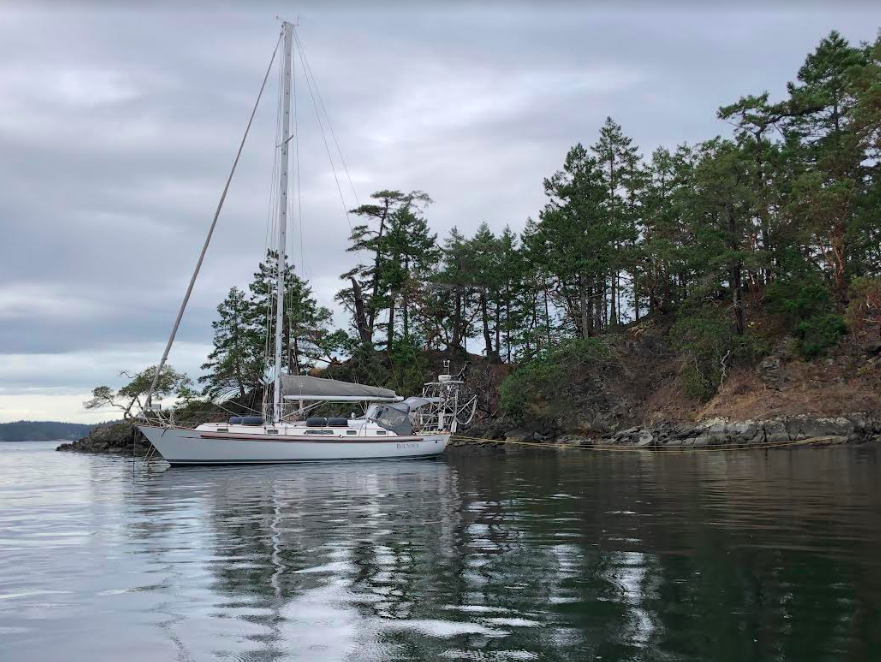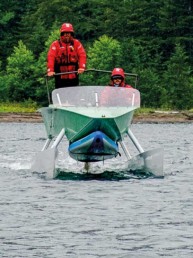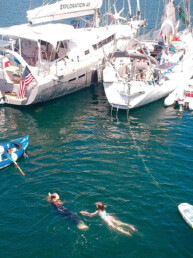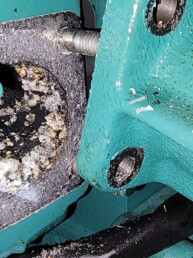48° North columnists Marty McOmber and Deborah Bach recently crossed the newly opened U.S.-Canada border in Sidney, British Columbia. Here’s how it went for them, along with some tips for other cruisers considering doing the same…
On Saturday, Aug. 14 we crossed the U.S.-Canada border aboard our Passport 40, Rounder, and checked in at Port Sidney Marina. I’m happy to report that our clearance was about as straightforward as it was before the COVID-19 pandemic upturned everything. The key for us was to clearly follow the steps outlined in the ArriveCAN app and to make sure all of our requirements for entry were in order.
Deborah is Canadian, and has dual nationality, so she has been across the land border several times over the past year. She learned early that Canadian customs and public health agencies were sticklers for meeting the requirements. Also, we both have NEXUS passes, which may have greatly helped us in clearing the border with no issues.
We began by reading up on the marine border crossing regulations at the Canadian Government’s published list of reporting requirements for private boaters.
The key bits are:
1) be asymptomatic;
2) have a valid pre-arrival COVID-19 molecular test result taken in the U.S. for U.S. boaters (antigen tests are not accepted) within the last 72 hours;
3) submit their mandatory information via ArriveCAN, including proof of vaccination in English or French (both vaccination doses, if applicable), and a quarantine plan; and;
4) be admissible under the Immigration and Refugee Protection Act.
We were staying in Port Townsend on the boat just before our planned entry. We found a local clinic that provided the proper molecular test and made an appointment for two days before we planned to enter Canada. It’s important to make sure you get the right kind of test. The at-home antigen tests that you can buy at the pharmacy are not accepted in Canada. You’ll need the one that requires a healthcare worker, nasal swab, lab assessment, and results in 24 to 48 hours.
We got our results electronically about a day and a half later. Fortunately, we were both negative. It’s very important that no more than 72 hours have elapsed from the time you took the test before entering Canada. If you miss that window, you will probably need a new test.
Deborah and I are fully vaccinated. We have our vaccination record cards with us, and I’d advise boaters to have the physical cards with them in case an agent requests it.
We downloaded the ArriveCAN app on our phones. This is important, because you must use that app to file your arrival plan and upload your proof of vaccination as well as a quarantine plan. Don’t skip this step or it will cause a lot of problems.
Apparently, the app was updated recently and the older version won’t work for filing your plan. So your best bet if you downloaded the app before Aug. 9 is to delete it and then download the latest version before filing your arrival plan.
The biggest question in our mind was regarding the quarantine plan. We have heard stories about Canada not allowing boaters who crossed earlier to use their boats as a place of quarantine. We also understood that if you met the other requirements for entry, that you wouldn’t need to quarantine.
The ArriveCAN app requires you to submit a quarantine plan, which is simply an address where you plan to quarantine, if required, along with a series of questions about that location — including if you have access to enough food, water, and heat for two weeks and if there are any other people who will be at that location.
We made a two-week reservation at Port Sidney Marina for our plan and made sure to tell the marina that it was likely we would not need the reservation and that it was made mostly due to the entry requirement. They seemed okay with that and were happy to oblige us. In the end, we didn’t need the reservation and called the marina to cancel it immediately after we were cleared into Canada. That kind of customer service ranks high for us and we will definitely do business with that marina in the future as a result.
The biggest change from pre-COVID times is that you need to go to an official port of entry that is staffed with customs officials (rather than arrive at one that isn’t staffed but provides for phone entry). The app requires you to indicate your port of entry in advance and gives you a selection to choose from. In our case, we chose the Port Sidney Marina. We heard from other boaters who tried to cross at Poets Cove in Bedwell Harbour that they were told they needed to go to an open port of entry. It’s still not clear to us if the choices in the app are all open and staffed, or if you need to know which are staffed and only select one of those.
The Check-in Experience
We filed our arrival plan via the app about 24 hours before we arrived. The app provides a receipt with a number on it to track your request. Make sure to note that number; the customs agent you deal with will need it. It is available in the app and we also got an email with the information.
With our negative test results in our email inbox, and our arrival plan filed via the ArriveCAN app, we shoved off early from Port Townsend and arrived at the Port Sidney customs dock around 10:30 a.m.
One large motor-cruiser arrived just ahead of us at the customs dock, which had a small shack for a customs agent. Strangely, we could see no one in the shack or the master of the motor yacht, so it was difficult to figure out what was going on. We chose to be patient and he departed about 45 minutes later, a smile on his face after apparently getting the go ahead.
Still, we were concerned that it seemed to take forever for him to clear. What would be in store for us?
We tied up to the customs dock and found that no one was currently staffing it. Another U.S.-flagged vessel arrived just after us, but otherwise it wasn’t very busy at 11 a.m. on a Saturday.
There was a sandwich board in front of the shack with the number to call customs, which we did. I was quickly connected to an agent on the phone, who asked the standard series of questions — did we have any alcohol, tobacco or firearms aboard, etc. — in addition to specific questions about whether we were experiencing any COVID symptoms. She asked for the receipt number from our ArriveCAN app and she quickly located our plan, including the uploaded images of our vaccination cards.

We’re In!
A few minutes later, she gave us our clearance number and wished us well. We were in. From start to finish, the call took about 10 minutes and there was no mention of our quarantine plan or whether we would need to take any additional COVID tests.
The following day, I received a form email from Canadian customs noting that, should I be randomly selected to take an additional COVID test, I had agreed to do so. So far, I have not been selected, but boaters should make sure their plans in Canadian waters are flexible enough to accommodate an additional test, if required.
We decided to stay that night at Port Sidney Marina. We noticed customs agents walking to the shack about an hour after our arrival. So apparently we simply arrived a bit before their shift began.
When we departed around noon the following day, there appeared to be about a half dozen boats waiting to clear in. The customs dock was staffed by two in-person agents, who were interviewing the boaters. All appeared to be going smoothly.
My takeaways are pretty easy from this whole experience:
1) Make sure you read all the requirements for entry and follow them to the letter.
2) Download a new version of the ArriveCAN app and file your plan in a timely matter with all the required information.
3) Make sure you get the right kind of COVID test — you will probably be denied entry if you try to use one of the quick, over-the-counter tests. Make sure the test is less than 72 hours old from the time it was administered.
4) Arrive at a staffed customs dock. I’m not sure how to determine which are staffed or not — and that might change on a regular basis. Be prepared to move your boat to a staffed location in case your initial port of entry isn’t.
5) Be patient and kind. This is new for everyone and you will need to be flexible and willing to accommodate any changes required of you.






